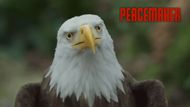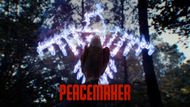Peacemaker has never been subtle. This is a show where helmets explode people’s faces, where satire and sincerity share the same frame, and where a bald eagle gives better hugs than most humans.
So, when Peacemaker season 2 whispered about something called the Prime Eagle, of course it was never going to stay a whisper. By the time Need I Say Door and Back to the Suture (episodes 4 and 5) arrived, Eagly was not just a sidekick anymore. He was destiny in feathers.
But destiny comes with baggage. Red St. Wild, Michael Rooker at his most unhinged, performed a ritual in the dirt, half-naked and dripping blood across his forehead while a power ballad by H.e.a.t. played in the background.
It was camp, it was grotesque, it was Peacemaker. And it was also maybe a little too close to something real. The symbol he drew looked a lot like the Thunderbird logo of the Anishinabek Nation. That’s when the internet stopped laughing and started asking questions.
From gag bird to mythic beast
Eagly used to be the punchline, the absurd pet that grounded Chris’s violence with cartoonish loyalty. He fetched helmets, he hugged on cue, he was the show’s pressure valve, proof that even in the bloodiest satire you need a creature that makes people go “aww.”
Then came the reveal: The Prime Eagle.
Suddenly every gag was prophecy, every flap of wings a mythic signal. The old man who muttered about a primal bird of destiny was not (at least not totally) deranged after all: but he was indeed doomed.
His death by a swarm of eagles felt like a punchline upgraded into ritual sacrifice. It was the kind of scene where you laugh, wince, and wonder if you just watched a prophecy unfold.
That is the magic trick. By naming Eagly the Prime Eagle, the show reframed him as a creature that carries weight, history, and even fate. And because Peacemaker loves a joke that gets too big for its cage, the series leaned into it until it felt biblical.

The ritual that raised eyebrows
Enter Red St. Wild, also called “Captain Cultural Appropriation” inside the show. In Need I Say Door, he buys into the myth completely. Thanks to a lie from Economos, he thinks killing the Prime Eagle will somehow cleanse America’s sins against Indigenous people, and that alone is satire sharpened into a razor blade.
So he dances. He strips down. Blood drips onto the dirt. A giant bird symbol scratches itself into the ground. It's shot like parody, scored like a redemption montage, but it carries the kind of imagery that does not stay on screen.
TikTok caught it first. User The High Ground put the symbol next to the Thunderbird logo of the Anishinabek Nation and the resemblance was impossible to ignore. The direction of the beak, the triangular chest, the feathers fanning in near-perfect count.
This was not just internet overreaction. The Thunderbird logo is not random clip art. It was designed in the 1970s by Nick Deleary and represents 39 First Nations in Ontario. This is cultural identity rendered in bold strokes, and, all of a sudden, it was also part of a DC show’s blood ritual joke.

The Thunderbird beyond Peacemaker
To understand why fans reacted so strongly, you have to understand what the Thunderbird means outside of Peacemaker. In Anishinaabe traditions, the Thunderbird is not just decoration. It's a doodem, or clan symbol, carrying spiritual and cultural weight. Representations of the Thunderbird go back centuries, tied to creation stories, natural forces, and community identity.
The Anishinabek Nation, a political advocacy group formed in 1949 that now represents 39 First Nations in Ontario, adopted the Thunderbird as its official logo in the 1970s. Designed by artist Nick Deleary, the emblem has become both a symbol of governance and a marker of unity for its member nations. It is not a generic eagle drawing. It is an image with roots in sacred traditions and modern political identity.
That is why the resemblance stung. When Red St. Wild smeared the blood-marked symbol on his forehead, the scene was not just borrowing generic “tribal” imagery. To some viewers, it looked like Peacemaker was co-opting a specific cultural emblem for a punchline. The weight of the Thunderbird outside the show turned a goofy montage into something much heavier.
And this is not only about copyright. As Marci Becking from the Anishinabek Nation explained, variations of the Thunderbird can be drawn in many ways. What matters is respect. Sports teams have asked for permission before using the logo, recognizing that even stylized versions carry meaning. The HBO Max production did not do that, at least not publicly, which is why this debate is not just about legal infringement; it's also about cultural responsibility.
Myth, parody, homage?
All of the above?
This is Peacemaker at its sharpest and its messiest. The show satirizes everything, even America’s sins, by filtering them through absurd rituals and blood smeared symbols; however, when the imagery lines up so closely with a symbol tied to living nations and cultures, parody becomes harder to defend.
Was it homage, an uncredited nod that ended up clumsy but not malicious? Was it appropriation, stripping a sacred image for a gag about a man who thinks eagle blood will cleanse genocide? Or was it just lazy design, a reference pulled from somewhere without thinking twice?
The problem is that once viewers notice, the intent almost does not matter. The conversation has already left the screen.

Why the Prime Eagle still matters
Controversy aside, the Prime Eagle is one of Peacemaker’s boldest narrative gambits. It reframes Eagly not just as a bird with perfect comedic timing but as a mythic creature that reshapes Chris’s own story. A man who has never believed he belonged is now tied to a symbol of loyalty, power, and fate.
That is what makes the whole thing sting. Because the Prime Eagle arc is strong enough to stand without borrowing from anything outside the show. It's funny, it's epic, it's exactly the kind of chaotic mythmaking Peacemaker thrives on. But by brushing up against Indigenous iconography, intentionally or not, the show added a layer of controversy that it may never fully shake.
The eagle that will not stop flying
In the end, the Prime Eagle is more than a twist. It's a storm. Inside the story, it's a myth that turns Eagly into a living legend. Outside the story, it's a flashpoint for cultural debate. Homage or appropriation, parody or parody gone too far, it has already given Peacemaker something it loves most: chaos.
Because only in this show could a hugging eagle become the center of mythology and controversy at the same time. The Prime Eagle has taken flight, and it's not landing any time soon.
